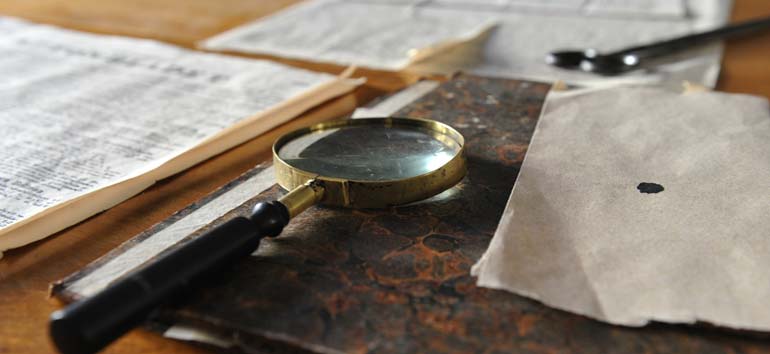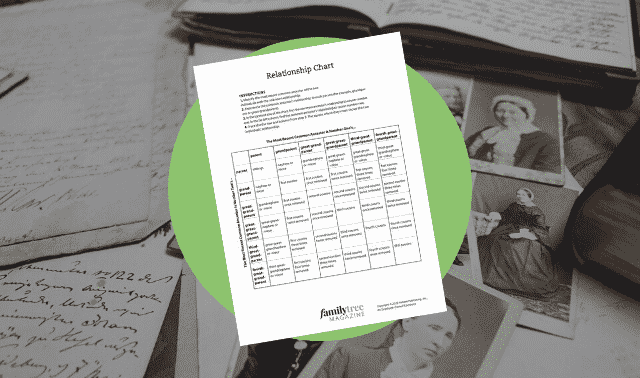Sign up for the Family Tree Newsletter Plus, you’ll receive our 10 Essential Genealogy Research Forms PDF as a special thank you!
Get Your Free Genealogy Forms
"*" indicates required fields

Inside every genealogist is a hidden (or a not-so-hidden) detective. We all love the thrill of the hunt and the challenge of a mysterious kinship. We hone our search skills, learn about records, and ponder the evidence. Yet there’s another aspect of detective work that we often brush aside—writing reports about our research.
Research reports are powerful investigative tools. In criminal cases, detectives use them to summarize, analyze and communicate findings. They can do the same for family history research. Professionals create them for clients, but most experienced genealogists also write reports on their family research, purely for their own files. Why? Because reports help them build on their discoveries to solve problems of identity and relationship.
And no matter where you are in your family history search, creating a report can help you, too. I’m confident that once you see how beneficial research reports are and how simple they can be to construct, you’ll be convinced they’re well worth your time.
The Benefits of Writing a Genealogy Research Report
It may seem counterproductive to use your limited research time writing about the work you’ve already done instead of searching for new records. But you’ll reap benefits that save you time in the long run. A research report chronicles the work you’ve done toward answering a particular question about your family history, identifying:
- the focus of your research problem
- the information with which you started
- the resources you used
- your research discoveries
- your thoughts and analysis
- your summary or conclusion
- your ideas for future research
Because your report shows what you looked for and found (or didn’t find), you won’t end up repeating searches. This is especially helpful if you’re juggling multiple projects or only have short intervals to work on genealogy. If you need to put your research efforts on pause for a while, the report makes it possible to come back and pick up where you left off without missing a beat.
The process of writing also clarifies your thinking. Because extracting the information from a document and analyzing it in writing forces you to slow down and think it over, you’re more likely to notice small but meaningful details, and put them together with details found in other documents. This aids you in determining what the evidence means. It also makes it easier to compare and correlate different pieces of information—a vital part of solving any problem.
If you’ve been working on an ancestor for some time, writing a report can help you gather your evidence discovered over time, and see where gaps might exist in your research. It’s a great way to brainstorm ideas for a new research plan, which you can even begin to develop right there in the report. A summary like this is also helpful if you want to ask a professional or a genealogical society for assistance. The person will be able to see what you’ve already done, so he or she can get up to speed on your query more quickly and won’t need to duplicate your previous work.
Similarly, if you’re starting on a new line or if friends or relatives have asked for your help with their family history, it’s a good idea to create a report at the outset and add to it as you go along. When you’ve finished, you can turn the report with documents you’ve found over to them, knowing your work won’t be lost or misunderstood.
Many genealogists also write reports on special research trips, such as to the Family History Library in Salt Lake City or to an area where ancestors lived. Such reports might be started before the trip, fleshed out during it, and polished up afterward at home. These trips often represent a big investment in time and money, and the records may not be available anywhere else. So it’s wise practice to keep track of the results and analyze them fully.
Who, then, can benefit from writing a research report? In short, anyone who:
- is working on a problem of ancestor identity or kinship
- needs to pause and resume research at a later time
- is trying to summarize previous work and generate new ideas
- is planning a trip to a repository or ancestral locality
- is looking for help from someone else
- is offering help to someone else
As you can see, that covers a wide range of territory. Fortunately, you can easily adapt reports to fit your own situation and needs. They don’t need to be fancy or complex to be useful. As a genealogy professional, I’ve written dozens of reports, and I’ve learned some keys to effective yet easy reporting to share with you.
Embrace a Write-As-You-Go Approach
In school, many of us learned to write reports after we’d finished reading the books and doing the research. For me, at least, that wasn’t much fun. Who wants to labor over a report after all the interesting work of discovery and synthesis is done? That’s why I’m among the many genealogists who’ve embraced a write-as-you-go approach.
Writing as you go simply means setting up the framework for your report when you first begin a new project or phase of work, and then filling in your results as you find them. Setting the report up when the question is fresh—before you undertake any new research or know the outcome—allows it to grow organically as your understanding of the evidence grows. You’ll find it flows more naturally and can actually help guide your research efforts.
It’s a good idea to create a short sample report in your word processing software to use as a template. That way, you don’t need to start from scratch each time you begin a new one. Even though the topic and resources will vary, the basic sections will be structured more or less the same. The following six steps will guide you in crafting a versatile report.
Six Steps to Writing Your Research Report
1. Identify your focus.
Whether the report is for your own research or someone else’s, the first step is to note your name, the date, and what the subject is. To begin, open a blank document and type in the following lines:
- Title
- Prepared by: (your name and contact information)
- Prepared for: (“My Research Files,” or the name of relative or fellow researcher)
- Date finished: (leave blank for now)
- Research question or goal
For the title, choose something more specific than, say, “Baker Family Research.” A title like “Searching for the Parents of Isaac Baker” might better reflect the true focus of the report. For a report following a research trip, try something like “Researching Bakers in Berkshire County Records at the Family History Library.”
Similarly, give some thought to your research question or goal. This is a short statement—typically just one or two sentences—but it sets the framework for your entire project. The research question has two important components: First, it needs to identify precisely the person or couple at the center of your research. This involves not only naming the person, but also placing him or her in a particular place during a particular time period. Second, it needs to explain what you hope to investigate and learn during the course of your research.
Stating a research question or goal isn’t as hard as it might sound, because the two components fit together seamlessly to express your objective. Questions and statements like these might strike you as lengthy at first, but you’ll soon get the hang of writing them. Some examples of a research question or goal include:
- Who were the parents of Isaac Baker, 1840 resident of Pittsfield, Berkshire County, Mass.?
- Was Catherine Anderson, who married Thomas Smith on 20 April 1859 in Cass County, Mo., the daughter of Cass County resident William Anderson?
- This project will explore sources of information at the Family History Library about Baker families living in Berkshire County, Mass., about 1800-1860.
2. Show what you know.
Now that you’ve defined your research objective in specific terms, offer a brief recap of what you already know about the subject. This section might be called “Starting Point,” “Background Information,” or “Summary of Previous Research.” Choose whichever term you prefer and enter it into your template.
Try to sum up what led you to this point in a couple of paragraphs. It isn’t necessary to write a full biography of the person’s life. Rather, think of it as a synopsis of information you’ve gathered pertaining to the research question. If you’ve developed a theory based on that information, now’s the time to explain what you think and why.
Indicate where the information came from, too. Have you been reading your great-aunt’s handwritten pedigree, a set of census records, an obituary clipping, an online family tree, or some combination of the above? Knowing the sources you started with will be important in judging the information’s reliability as you accumulate more evidence.
If you’ve done a lot of previous work, it could be helpful to attach a chart or timeline here for quick reference. In most cases, though, a few short paragraphs outlining the key players in the person’s life (spouses, children, siblings or parents, if known), pertinent dates and places, and clues you hope to build on will be enough to launch you forward.
3. List your resources.
Set up a section of your report near the beginning to serve as a master list of “Resources Used.” That way, you’ll be able to see the websites you searched, the libraries or archives you visited and/or the people you contacted at a glance. You’ll still want to write citations for each new document you find, but this list will help you write them and save you from digging through your footnotes if you forget whether you looked at a certain website.
To save time, create a list of frequently used resources in your report template, which you can add to or subtract from as needed. I divide mine into three parts: online sources, repositories visited and correspondence. For online sources, I list websites I commonly use with their home URLs, such as Ancestry.com and FamilySearch. For repositories visited, I list places I frequently research, including my local library and my state archive. Modify these lists for each report as you go along, deleting sources you didn’t use and inserting additional ones you did. The correspondence section stays blank until I get into a project. Then I add people or archives with whom I spoke on the phone or exchanged emails or letters.
If you have any limitations on your project, indicate them here as well. Perhaps you’re limited to five hours of work, or you’re focused solely on records created in Iowa, or you’re using online resources only. It may be important to know what those limiting factors were in the future, especially if you’re sharing your report with others.
4. Report your findings.
This section, typically called “Research Findings” or “Research Notes,” will comprise the body of your research report. It’s where you’ll record the nitty-gritty details of the information found in the sources you looked at, complete with source citations. It’s also the place where you’ll analyze and begin to compare the evidence. Every source in your Research Findings should receive a three-part treatment:
- Abstract or transcribe information from the record
- Write a source citation as a footnote or endnote
- Analyze what the record tells you or suggests
Since you’ll probably be looking at a number of sources, you’ll want to organize or group them in some way. Grouping by type of record—such as census records, marriage records, probate records, newspaper records, etc.—is a common and natural way to structure your research findings. If you’re gathering records from different localities, like deeds from three different counties, you could organize by locality instead. In some cases, grouping by time period or by person might make the most sense. Choose the type of grouping that works well for your particular project.
For example, let’s say you want to organize by record types. Create a heading for, say, “Census Records.” If your first record is the 1860 US census, make a subheading for that. With the digitized image of the census in front of you, write down all the information it contains. You might use bullet points to create a list of household members, in the order in which they appear, with age, sex, occupation and so forth for each one. This is the process of abstracting the record—recounting the information faithfully in shortened form.
Some records, such as a minister’s return of a marriage, lend themselves better to transcribing—copying the entire record word-for-word, exactly as it appears. Transcriptions should appear with quotation marks around them. Your report will likely contain a mixture of abstracts and transcriptions.
Once you’ve captured what the record says, note where it came from. All word processing programs allow you to create footnotes and endnotes, which are ideal for source citations. Many people prefer footnotes, as this keeps the information and citation together on the same page, but endnotes are also fine. If you don’t know how to create footnotes in your software, you could put your citations in parentheses or brackets following the abstracted information.
Now, think about what this information means. What’s significant about it? Does it answer a question, or suggest a direction to explore? Does it raise additional questions? In a separate paragraph labeled “Analysis” or “Comments,” offer your thoughts and observations. Allow yourself time to reflect on the information and how it relates to other evidence you’ve collected. Does it agree or disagree with other findings?
This analysis is truly the heart of your report. As you proceed with your research, patterns, similarities and/or discrepancies may start to appear. Consider these carefully and think about why. Through this process, analysis leads into correlation. In his landmark book, Mastering Genealogical Proof (National Genealogical Society), board-certified genealogist Thomas W. Jones defines correlation as “a process of comparing and contrasting genealogical information and evidence to reveal conflicts, parallels and patterns.” In most cases, this is how you’ll reach your research objective.
One last note: in addition to recording the sources you found, it’s also important to note when your searches came up empty. If you expected to find a marriage record for your ancestors in Boone County, Ky., but didn’t find one, indicate exactly what online database(s), microfilm, published record books or other resources you consulted. Keeping track of these negative results helps you avoid repeating work, and can spur you to expand your search to other localities.
5. Sum it up.
Once you’ve finished all the research, read over and polish your report. Edit it for grammar, style and clarity. Then, while it’s fresh in your mind, write a “Summary of Results” or “Conclusion” section to summarize what you discovered. Have you answered your research question? What can you infer or conclude in light of the evidence you found?
Since you’ve been analyzing the evidence all along, this summary should be relatively simple to write. It’ll draw from and expand on the analysis and correlation you’ve already done. Nonetheless, you may find the process of synthesizing everything together sparks more ideas and connections. That’s one of the reasons you’re taking the time to write a report in the first place.
Your summary might also expose conflicts between pieces of evidence. Can you explain or resolve those conflicts? If so, this is the place to say how. If not, you may simply need to acknowledge that the evidence disagrees, and that more work is needed in order to resolve the matter.
6. Plan for the future.
In the final section of your report, “Recommendations,” list any additional resources you’d like to look at in the future. These will be based on ideas that came to mind while you were researching or evaluating the evidence. Recommendations for future research might include:
- other records to explore, such as military or land records
- visiting a certain archives or repository
- digging into records of another city, county or state
- newly discovered relatives or associates to investigate
It’s a good idea to add things to this list as they occur to you during the writing and proofreading process, and then finalize it at the end. Think about where you’d like to go from here. Your list of recommendations can serve as a ready-made research plan for your next round of family history discoveries.
At last it’s time to sit back, relax and look with pride at the report you created. With any luck, you’ve met your research objective, or at least made strides in the right direction. It’s always a good idea to make a backup copy. Save your report, along with any records it refers to, on a cloud-based server, such as Evernote, Google Drive or Dropbox (a “List of Attached Records” makes a handy index to include in the report). This ensures you’ll be able to access the documents anytime and anywhere. Cloud storage also makes it easy to share your findings, simply by inviting others to view the file.
Investigative reporters know that focusing attention on a problem in writing is one of the best ways to spur action and generate solutions. Many genealogical problems can benefit from the same treatment. So next time you’re faced with an ancestral mystery, take the time to start a report for yourself. You may find the answer is right there in black and white.
A version of this article appeared in the September 2016 issue of Family Tree Magazine.
ADVERTISEMENT








